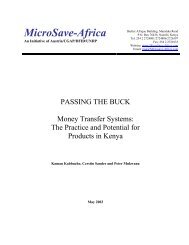You also want an ePaper? Increase the reach of your titles
YUMPU automatically turns print PDFs into web optimized ePapers that Google loves.
In 2005, <strong>DAI</strong> began working to create a more cohesive brand<br />
identity. The new brand, unveiled at the May 2006 staff<br />
conference, was striking in its simplicity and its departure from<br />
convention. At its heart was a new logo, soon dubbed the “<strong>DAI</strong><br />
Flag,” which consisted <strong>of</strong> three bars <strong>of</strong> color, with the brown<br />
representing strong foundations, the green signifying results,<br />
and the blue evoking aspirations—both those <strong>of</strong> the company<br />
and those “that our clients and beneficiaries hold for their own<br />
future.” The award-winning new scheme was immediately<br />
successful, as employees quickly embraced the step toward<br />
forging a one-company mentality.<br />
One <strong>of</strong> the things <strong>DAI</strong> celebrates most visibly is employee<br />
tenure, with public acknowledgment for all employees passing<br />
key milestones. Pictured from left to right are Carol Kulski, Tami<br />
Fries, and Tony Johnson, who have celebrated their 25-, 20-, and<br />
25-year anniversaries with the company, respectively.<br />
88<br />
commissioned Houlihan Lokey, an investment banking firm<br />
with a strong ESOP practice, to evaluate the options for ownership<br />
and compare the ESOP to other investment vehicles.<br />
Over the course <strong>of</strong> several meetings in 2005, the Board<br />
debated the Houlihan Lokey report, which recommended a<br />
recapitalization <strong>of</strong> <strong>DAI</strong> based on the use <strong>of</strong> new bank debt to<br />
buy back all shares owned by individuals. This would leave<br />
the ESOP as <strong>DAI</strong>’s sole owner, after which <strong>DAI</strong> would convert<br />
to a Subchapter S corporation. Going forward would require<br />
taking on significant long-term debt ($15 million to be repaid<br />
over five <strong>years</strong>) as well as the willingness <strong>of</strong> all 70 individuals<br />
to sell their shares. The Board took pains to ensure that <strong>DAI</strong><br />
was prepared on both counts. Although at least one external<br />
director expressed concern that management seemed to be<br />
putting employee ownership ahead <strong>of</strong> other strategic considerations,<br />
Jim Boomgard insisted that “independence is a<br />
critical part <strong>of</strong> our DNA,” and the transaction was approved. It<br />
closed in December, and to the surprise <strong>of</strong> the attorney who<br />
handled the paperwork, all 70 individual shareholders willingly<br />
tendered their stock, receiving an excellent return on the<br />
funds they had invested in prior <strong>years</strong>.<br />
To access the necessary funds, <strong>DAI</strong> negotiated a new credit<br />
agreement, this time with a syndicate <strong>of</strong> five banks, combining<br />
the $15 million term loan with a $60 million revolving<br />
credit line that could be used to finance accounts receivable<br />
as the company continued to grow. The result was a<br />
much closer alignment between its capital structure and its<br />
employees’ interest in enhancing their own financial wellbeing<br />
through steady, long-term appreciation in the value <strong>of</strong><br />
the firm. As Boomgard put it, “We make a lot <strong>of</strong> decisions<br />
over the course <strong>of</strong> any year that wouldn’t satisfy an outside<br />
financial investor, or a public company focused on meeting its<br />
quarterly earnings forecasts, but are the right things to do for<br />
our employee owners.”



